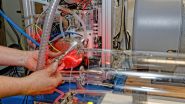Genomic data reveals emergence in Africa of drug resistant strain of typhoid
2015-05-26
(Press-News.org) The team has completed two genomics studies on the tropical disease, a condition that is estimated to cause up to 30 million illnesses and over a quarter of a million deaths globally each year.
The first study, published in the journal Nature Genetics, suggests that the H58-strain, which is likely to have emerged in Asia approximately thirty years ago, is now rapidly spreading across Africa, where it has been introduced on several separate occasions. A key feature of this strain appears to be its ability to acquire resistance to commonly available antibiotics.
Dr Melita Gordon, from the University of Liverpool's Institute of Infection and Global Health, said: "Importantly, the antibiotic resistance genes, which have previously been carried on a separate genetic package, have now been incorporated into the main chromosome of the bacteria itself, which is likely to make it easier for the Typhoid strain to retain these resistance genes."
Data from the microbiology laboratory at the Malawi-Liverpool-Wellcome Trust Major Overseas Programme, where bloodstream infections have been monitored for 18 years, show that an epidemic of Typhoid fever began in Malawi in 2011.
In a related study, published in the journal PLoS Neglected Tropical Diseases, the team has investigated the epidemic and the re-emergence of the disease in Malawi by studying the genomes of the bacteria.
Genomic data from the Malawi strains reveals that up until 2009 no H58 strains were found, and other local strains of Salmonella Typhi were fully sensitive to the antibiotics used locally.
After 2010, a large number of different strains, however, appeared in Blantyre, competing for dominance. H58 emerged as the most successful strain, triggering a large epidemic in which up to 800 cases occurred per year, with a 3% case fatality.
Dr Nick Feasey, from the Liverpool School of Tropical Medicine said: "The rise of antibiotic resistance among Salmonellae in Africa is a major threat and concern. Not only does it mean that individuals cannot always be effectively treated, but it also appears to make global spread and large epidemics more likely."
Liverpool scientists are now conducting further work at the Malawi-Liverpool-Wellcome Trust Clinical Research Programme, funded by a £4 million Strategic Award from the Wellcome Trust, as part of a team led by the University of Oxford Vaccine Group, to investigate the best ways to use future vaccines to halt the spread of multidrug resistant Typhoid fever in Africa.
INFORMATION:
ELSE PRESS RELEASES FROM THIS DATE:
2015-05-26
TORONTO, May 27, 2015--A good working relationship with police is essential for the smooth operation of a busy Emergency Department. Police are in and out of EDs regularly, supporting EMS, transporting patients and helping to provide a safe environment for hospital staff.
Not surprisingly, differences of opinion arise from time to time over a health care worker's duty to protect patient privacy and the police need to conduct a criminal investigation.
That's why it's essential to develop strategies to optimize communications between police and ED workers, according to ...
2015-05-26
ATHENS, GA - Over the past century, many forests have shifted from open to closed canopies. The change in forest structure could be contributing to declines in pollinator species, especially native bees, according to a new study by U.S. Forest Service scientists.
The study shows how common present-day forest conditions affect pollinators, especially bees. "Bees prefer open forests," says Jim Hanula, a research entomologist at the Southern Research Station (SRS) Insects, Diseases, and Invasive Plants research unit. "We found that total tree basal area was the best predictor ...
2015-05-26
WASHINGTON, May 26, 2015 -- You might have heard that microwaving your food is dangerous. Maybe your health nut friend told you that eating frozen veggies is less healthful than eating fresh ones. Is a glass of red wine really good for your heart? This week, Reactions is here to sort out the "old wives' tales" from the facts, taking on a swath of food myths. Check out the videos here: http://bit.ly/ACSFoodMyths.
Subscribe to the series at http://bit.ly/ACSReactions, and follow us on Twitter @ACSreactions to be the first to see our latest videos.
INFORMATION:
The ...
2015-05-26
CLEMSON, S.C. -- If you've been to the doctor, you probably know what to do when you're handed a plastic cup and shown to the bathroom.
Most patients hand over the sample and give little thought to what happens when it's shipped to the lab for analysis.
Ken Marcus and his students are the exceptions. They have developed a new testing method that they believe will reduce costs, get faster results and lower the volume of urine needed for a sample.
Marissa Pierson, a master's student, closes the lid on a centrifuge while working in a Clemson University lab with Ken Marcus.
It's ...
2015-05-26
This news release is available in German.
Quantum physics is full of fascinating phenomena. Take, for instance, the cat from the famous thought experiment by the physicist Erwin Schrodinger. The cat can be dead and alive at once, since its life depends on the quantum mechanically determined state of a radioactively decaying atom which, in turn, releases toxic gas into the cat's cage. As long as one hasn't measured the state of the atom, one knows nothing about the poor cat's health either - atom and kitty are intimately "entangled" with each other.
Equally striking, ...
2015-05-26
This news release is available in German.
Leipzig / Helsinki. A first global scale study has estimated how forest emitted compounds affecting cloud seeds via formation of low-volatility vapours. According to the latest projections, terrestrial vegetation emits several million tons of extremely low-volatility organic compounds (ELVOCs) per year to the atmosphere. These oxidation products of compounds such as monoterpenes results in an increase of condensing vapours that can further form cloud condensation nuclei over the continents and thus has an influence ...
2015-05-26
Montréal, May 25, 2015 - A team of researchers at the IRCM led by François Robert, PhD, uncovered a critical role for two proteins in chromatin structure. Their breakthrough, recently published in the scientific journal Molecular Cell, helps explain how DNA is organized in our cells. This discovery could lead to a better understanding of what causes certain types of cancer, such as lymphoma.
Dr. Robert and his team study chromatin, the structure composed of DNA and proteins that makes up chromosomes. Its main role is to package DNA molecules containing all the ...
2015-05-26
LOS ANGELES (May 26, 2015) - Biomedical researchers at Cedars-Sinai have invented a tiny drug-delivery system that can identify cancer cell types in the brain through "virtual biopsies" and then attack the molecular structure of the disease.
If laboratory research with mice is borne out in human studies, the results could be used to deliver nano-scale drugs that can distinguish and fight tumor cells in the brain without resorting to surgery.
"Our nanodrug can be engineered to carry a variety of drugs, proteins and genetic materials to attack tumors on several fronts ...
2015-05-26
Queen's University PhD student Matt Shultz is researching magnetic, massive stars, and his research has uncovered questions concerning the behaviour of plasma within their magnetospheres.
Drawing upon the extensive dataset assembled by the international Magnetism in Massive Stars (MiMeS) collaboration, led by Mr. Shultz's supervisor, Queen's professor Gregg Wade, along with some of his own observations collected with both the Canada-France-Hawaii Telescope and the European Southern Observatory's Very Large Telescope, Mr. Shultz is conducting the first systematic population ...
2015-05-26
Washington, D.C. -- May 26, 2015 -- A new study has demonstrated that a protein called Niemann-Pick C1 (NPC1) is critical for the Ebola virus to infect a host. The study, published in the May/June issue of mBio, the online open-access journal of the American Society for Microbiology, suggests that drugs that block NPC1 could be used to treat this deadly disease.
"The science behind the concept of blocking the interaction between NPC1 and the virus is solid. Now, it is just a matter of powering through and identifying drugs that can inhibit NPC1 and moving them forward," ...
LAST 30 PRESS RELEASES:
[Press-News.org] Genomic data reveals emergence in Africa of drug resistant strain of typhoid


